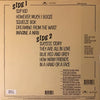







The Who – The Who By Numbers (Half Speed Mastering)
The Who [click here to see more vinyl featuring The Who]:
- Roger Daltrey – lead vocals
- Pete Townshend – guitar, keyboards, banjo, accordion, ukulele, backing vocals, lead vocals (A2, B3)
- John Entwistle – bass, French horn, trumpet, backing vocals, 2nd lead vocal (B1)
- Keith Moon – drums
Nicky Hopkins – piano
Written by Pete Townshend (all tracks except B1), John Entwistle (B1)
1 LP, standard sleeve
Original analog Master tape : YES
Half speed Mastering
Heavy Press : 180g
Record color : black
Speed : 33 RPM
Size : 12'’
Stereo
Studio
Record Press : Optimal Media (Germany)
Label : Polydor
Original Label : Polydor
Recorded in April – 12 June 1975 at Shepperton Studios' soundstage (Shepperton, Surrey, England) using Ronnie Lane's Mobile Studio
Engineered, mixed and produced by Glyn Johns
Mixed at Island Studios
Mastered by Jon Astley at Close To The Edge
Lacquer cut by Miles Showell at Abbey Road Studios
Originally released in October 1975
Reissued in February 2024
Tracks:
Side A:
- Slip Kid
- However Much I Booze
- Squeeze Box
- Dreaming From the Waist
- Imagine a Man
Side B:
- Success Story
- They Are All in Love
- Blue, Red and Grey
- How Many Friends
- In a Hand or a Face
Reviews:
“The Who by Numbers functions as Pete Townshend's confessional singer/songwriter album, as he chronicles his problems with alcohol ("However Much I Booze"), women ("Dreaming From the Waist" and "They Are All in Love"), and life in general. However, his introspective musings are rendered ineffective by Roger Daltrey's bluster and the cloying, lightweight filler of "Squeeze Box." In addition, Townshend's songs tend to be underdeveloped, relying on verbosity instead of melodicism, with only the simple power of "Slip Kid," the grace of "Blue Red and Grey," and John Entwistle's heavy rocker "Success Story" making much of an impact.” AllMusic Review by Stephen Thomas Erlewine
Half-speed mastering. In half-speed mastering, the whole process is slowed down to half of the original speed. A typical 33 1/3 rpm record is cut at 16 2/3 rpm. The source material is also slowed down (reducing the pitch in the process) meaning the final record will still sound normal when played back. Slowing the whole process down allows more time, which means the end result sounds better and is more efficient — allowing engineering to minimize the effects of inherent limitations within the vinyl format. The result is a more accurate and more open high-frequency response in the half speed vinyl when compared with a normal speed recording.
Ratings :
AllMusic : 4 / 5 ; Discogs : 4.5 / 5


